How Many Companies Are Using Design Thinking
For many companies, the design process is still locked inside a small creative room. Designers do not effectively contribute to building the business as the design is seen as a tool rather than a strategy. On the other hand, a quick look at the markets can tell us more about how the holistic approach of design can help building a successful business. Companies such as Apple, Microsoft, IKEA, Lego, Google, and other successful companies are integrating design at the top of their company strategies using thedesign thinking, and design managers make a high-level contribution with the executive body to take strategic decisions that can contribute to the product success.
So, what is the difference between design-driven companies and other companies, and what can design do for companies in terms of product development and other factors such as achieving innovation and business success? In this article, we investigate the term "design thinking" as one of the terms that were highlighted in the last few years as one of the methods that can help build a holistic understanding of the design processes inside companies. In addition, we look at the benefits that can be acquired through applying design thinking inside companies.
Related articles:
- How Design Thinking Reshaped Microsoft Products
- Design Thinking Case Study: Innovation at Apple
- IBM Design Thinking Model: A Shift Toward Big Enterprises
- Practice Guide to Run a Google Design Sprint
What is Design Thinking?
There is notable confusion about the meaning of design thinking, and this confusion can be observed inside and outside the design body. This confusion is caused by the way we define design in relation to its own components and the other fields of human knowledge, including science and art. Therefore, before moving to define the design thinking, we should have a clear definition of what is design. In his book, Designerly Ways of Knowing, Professor Nigel Cross provided a holistic definition for the design as following:
"Everything we have around us has been designed. Design ability is, in fact, one of the three fundamental dimensions of human intelligence. Design, science, and art form an 'AND' not an 'OR' relationship to create the incredible human cognitive ability."
Science — finding similarities among things that are different
Art — finding differences among things that are similar
Design — creating feasible 'wholes' from infeasible 'parts'
In terms of the design components, Steve Jobs successfully defined design in one of his quotes as: "Most people make the mistake of thinking design is what it looks like. People think it's this veneer — that the designers are handed this box and told, 'Make it look good!' That's not what we think design is. It's not just what it looks like and feels like. Design is how it works."
Based on the above, design can be seen as a process that created the "wholes" from the "parts," those parts include not only the look and the feel of the designer product but also how it works. This process is the design process, also known as the design thinking process.
Design thinking is a user-centered methodology that is used by designers to solve problems and find desirable solutions for consumers. it is a process that is based on a consumer-driven strategy that aims to ensure that the user is at the heart of the design process stages, starting from defining the problem, ending by delivering the solution in a form of a final product, and getting the user feedback that will be part of a continuous iterative process that will be used to improve the designed product or service in the future.
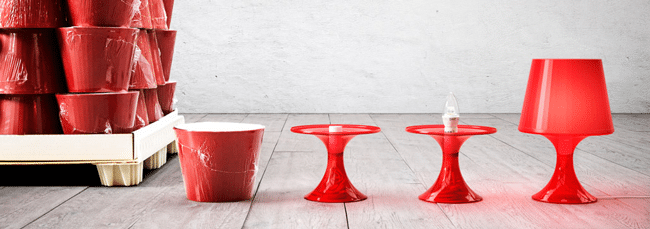
Tim Brown, the CEO for IDEO, the leading design company, defines design thinking as: "Design thinking can be described as a discipline that uses the designer's sensibility and methods to match people's needs with what is technologically feasible and what a viable business strategy can convert into customer value and market opportunity."
Mini case study: Democratic Design at IKEA
IKEA is one of the leading companies in the field of home and furniture product design industry. IKEA's Democratic design strategy integrates different principles into the product development process in order to achieve "good design." Their policy ensures that each of IKEA's products should achieve the following five principles:
Form: the look and the feel of the product should be desirable and beautiful
Function: the product should be usable and solve one of the consumer problems efficiently. The product should consider all the human-factors related to how the consumers use the product.
Quality: the quality of the product includes choosing the proper materials in designing its products.
Sustainability: products should be eco-friendly by reducing the waste, carbon emissions, and the consumption of the Earth's resources.
Low price: the product should be available at an affordable price for as many people as possible.
The above case study provides a successful example of having a clear understanding of the design process. For many companies, design has a very narrow definition that minimizes the value expected in the final product or service.
Why do we Need to Apply Design Thinking?
In the last few years, an increasing understanding of the design thinking process can be observed. Last year, McKinsey&Company, one of the world's leading product development advisory firms, published a report about the importance of building a design-driven culture inside companies. The mini case studies highlighted in this article provide successful examples of applying the design thinking process. So, what are the values that can be achieved through applying the design thinking inside the company? Below is a list of the prospective benefits that can be achieved through applying design thinking:
Focus on the User Experience
As highlighted above, the design thinking process is having one ultimate goal which is the address the people's need and problems in order to achieve a user-centered product design. However, this approach takes into consideration the emotional experience in addition to the other user experience factors. In his article for the Harvard Business Review, Jon Kolko provides a clear example of the emotional experience and its relation to the product value proposition: "If you buy a Lexus, the automaker promises that you will receive safe and comfortable transportation in a well-designed high-performance vehicle. An emotional value proposition is a promise of feeling: If you buy a Lexus, the automaker promises that you will feel pampered, luxurious, and affluent."
This emotional value proposition can be only achieved through adopting the design thinking to create the so-called empathic design. The empathic design aims to put the designers in the shoe of the end user by giving them the chance to see how they feel and respond to the product. In an interview on Dezeen, Marcus Engman highlighted that the design process in IKEA starts at people's homes in order to find out what they really need. This step is part of the emphasize phase in the design thinking process.

Mini Case Study: Design Thinking at Microsoft
Microsoft, the world's leading supplier of systems software, has been a technology-driven organization for a long time. Currently, Microsoft is using design thinking to focus on the user needs and user experience. In order to achieve this, Microsoft adopted a strategy to focus on user experience, integrate designers with the product development teams, deliver practice methods to designers, apply design principles across the business, and extend the usage of user research methods to improve the user experience.
In order to achieve this strategy, Microsoft adopted a user-centric design process of five stages: Understand, Envision, Specify, Implement, and Maintain. These stages are very similar to the design processes highlighted earlier. In addition to the design process, Microsoft involved the design on different levels, such as the following:
Project management periodic meetings to follow-up with the progress and ensure that the target goals are met
Using evaluation methods to learn more about the users' satisfaction and learn about their experience
Testing the prototypes through adopting a user testing and evaluation methods.
Design Thinking Fuels Innovation
In his article in the Stanford Social Innovation Review, Tim Brown highlighted that "Design thinking is scalable and can be applied incrementally to improve existing ideas (such as how a service is delivered or how a product performs for the user) or it can be applied radically to create disruptive solutions that meet the needs of people in entirely new ways." These characteristics of design thinking promote contribution in different types of innovation, including disruptive, sustaining, and breakthrough innovation.
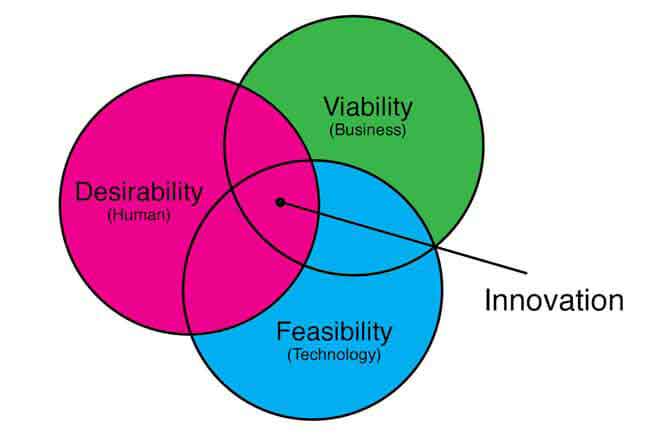
The nature of the design thinking process contribute fueling the innovation inside the company as achieving innovation requires the consideration of three main factors: technology, business, and human values. Those three factors can be achieved from within the design thinking process when targeting the below three goals while performing the process:
User desirability: the product should stratify the consumer's needs through solving their everyday problems using a user-centric approach.
Business viability: an integrated business strategy should be considered in order to ensure the product success in the market.
Technology possibility: technology should be considered an essential part of the new product development process (NPD) as it is considered a powerful tool for designers to achieve innovation.
Mini Case Study: Design Thinking at Apple
In my article, Design Thinking Case Study: Innovation at Apple, I investigated the footprints of the dramatic shift of Apple products and how it related to design thinking. After Steve Job's return to Apple in 1997, he initiated a new design thinking process in order to help the company pass its hard time during the period 1985-1997 and achieve market success. His strategy, which was given the slogan "Think Different!", was based on applying the design thinking goals above the product process. So, he focused on the following:
Focus on the user needs rather than the business needs
Build an empathic relation between the users and their Apple products
Focus on the design rather than the engineering as designers are able to consider both the form and the function in the product design
Create simple products that target user needs rather than complex and hard-to-use products

Find Solutions for Complex Problems
In addition to the nature of the design thinking process, its different stages can help the design team to brainstorm solutions for complex problems that were not solved previously. During each stage, creative tools can be used to find uncommon solutions or address the problem differently. In the Define stage, tools such as affinity diagram can be used to organize collected data and the cause and effect diagram can be used to investigate the causes behind a specific problem.
Design thinking can also integrate with tools such as the SWOT analysis, TRIZ problem solving to improve the efficiency of the final product. For example, the TRIZ method is a common tool to address complex problems and achieve innovation. This tool can be used in the Define and Prototype stages to reach an innovative solution for problems.
In addition to the above benefits of applying the design thinking process, other advantages can be highlighted such as increasing the company profits and market competitiveness. There is a positive correlation between design thinking and achieving innovation which has been proven as a successful factor to achieve profit and improve the market competitiveness. In the Profitable Innovation book by Dr. Georg Tacke, David Vidal, and Jan Haemer, five options have been highlighted to improve the market position of the product or the company, at the top of the list comes the introduction of new, innovation, differentiated products with 77% percent which can be considered an additional advantage of applying the design thinking process.
How to Apply Design Thinking models
Different models have been introduced to define the design thinking process. While these models vary based on their approach, number of stages, the relation between stages, and naming of each stage, most of the models follow a similar process flow that includes finding the problems that need to be solved, defining the problem and the design scope, creating the prototype, designing the final product, and gathering feedback. Below is an overview of the common design thinking models and the differences between them:
Stanford D.School Design Thinking
One of the common design thinking models is the D.School design thinking, which can be considered a straightforward process consisting of five stages described below:
Empathy: this stage aims to find the problem that needs to solved through the product or the service. The problem usually presents a gap between what consumers need and what they already have. This is where the user experience research is applied to collect information about the users' demographic information, behavior, environment, and needs.
Define: at this stage, the collected data is analyzed and organized in order to have a clear picture of the problem and user needs.
Ideate: the designers come to a solution for the problem in a form of a product or a service to be delivered to the end user. At this stage, the solution is defined in written format to be followed in the following prototyping stage.
Prototype: prototyping is considered the core of the design thinking process as it presents a transformation of the idea into a prototype for the suggested solution. This visual prototype allows them to evaluate the idea and determine whether it meets the target.
Test: this can be considered the first iteration stage in this model where the prototype is tested and feedback is given until it reaches the final product.
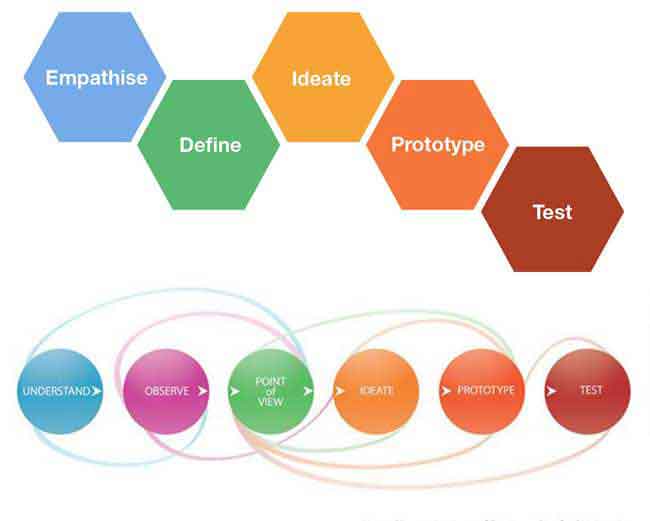
This model, shown in the figure below, does not clearly describe one of the essential elements of the design thinking process which is the iteration. A related version developed by the Hasso Plattner Institute in Germany introduced a continuous iteration between all the stages. After finalizing each stage, the iteration process ensures the initial design strategy is still valid and the requirements are met. If there is a problem or specific failure, the iteration process defines the stage where the failure occurred before returning to this point in order to fix the failure.
The simplicity of this model is considered both an advantage and disadvantage; while the simple, clear stages make it easy for designers to understand the different stages of the design thinking process, it does not define some essential stages such as the delivery of the product and the feedback that should be collected from the user and used to improve the future versions of the designed product or service.
ZURB Design Thinking
The ZURB Design Thinking Model is one of the interesting models that share the D.School's simplicity, yet it tends to consider important stages such as building the final product and getting feedback. The ZURB model includes five stages;Define, Ideas, Prototype, Build and Analyze. The last two stages represent the build of the final product and analysis of the market impact and user feedback.
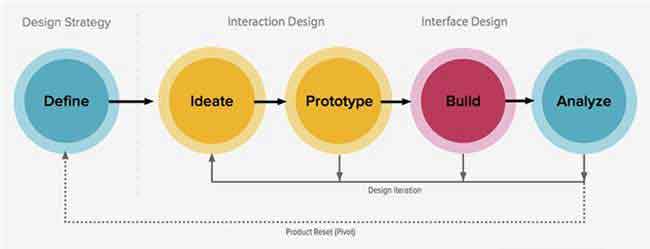
This model presents two types of the iteration cycles; the design treats ion, and the product reset (pivot). The first type includes the iteration between the stages; ideate, prototype, build and analyze. If there is something wrong happens, the team can iterative between the four stages above to file problems and improve the product. The second iteration process is a hard reset. If there is a major failure or the product does not meet the requirements, the product resets and returns directly to the ideate stage to repeat the process from scratch and define the problem again.
Double-Diamond Design Thinking
The Double Diamond Diagram was developed by the British Design Council in 2005 as part of their in-house research to identify how leading companies manage the design process. The Design Council process include four main stages; Discover, Define, Develop, and Deliver. The first two stages define the project strategy, while the third and fourth represents the executive solution.
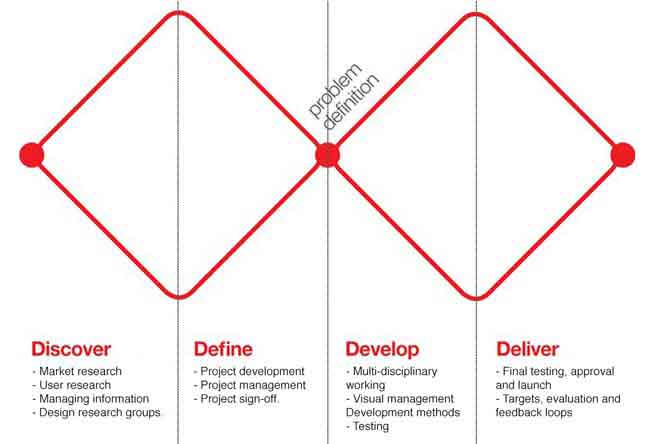
The process starts with a trigger point which can be an idea or a problem that influence the team to "understand" it and research the available knowledge about the targeted problem. This is a research stage where research activities can be conducted such as marketing research, user research, managing information, and design research groups. Following the "Understand" stage, the "Define" stage represents defining the project objectives and goals. Activities that can be achieved during the "Define" stage includes project development, project management, and project sign-off.
The second part of the Double Diamond Diagram includes the "Develop" stage which includes developing the prototype, iterate and tests it in order to ensure it meets the project goals. This stage involves multidisciplinary work: visual management, development methods, and testing. The last stage is "Deliver" where the final product is finalized and delivered to the market. The activities in this stage involved final testing, product approval, evaluation, and feedback.
The Double Diamond Diagram was part of the Design Council research which included eleven case studies of leading companies such as LEGO, Alessi, Microsoft, Sony, Starbucks, and others. Therefore, the presented model has been developed based on different types of companies, which has resulted in it being adopted by a wide range of companies.
IBM Design Thinking Process
One of the recently published design thinking models is the IBM design thinking. In 2013, IBM started a project to build a design-driven culture. The project took around three years, involved more than 750 designers and affected over 10,000 employees in the company. The project aims to build a design process that ensures a clear understanding of the consumer needs and build empathy. Additionally, the new model was placed to be remarked with the speed and scalability to meet the demand of modern companies. While the previous models were more biased towards small and medium enterprises (SMEs), IBM's model targets a larger scale of companies including large enterprises such as IBM (which has more than 385,000 employees).
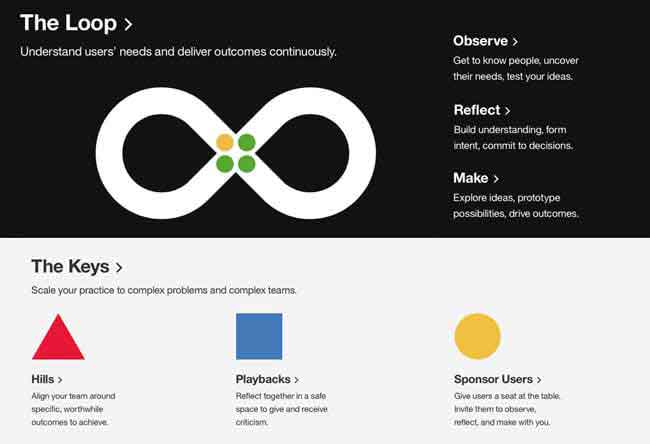
The IBM design thinking model consists of three stages: Observe, Reflect, Make. Those stages form the so-called "Loop." The first stage, "Observe", focuses on observing and building a better understanding of the problem. The second stage, "Reflect", allows the design team to analyze the knowledge in order to adopt it into the project plan. The last stage, "Make", reflects creating the product prototype and delivering it to the end user. In this model, IBM assumes that there is no final product; all the so-called final products are prototypes that can be improved in accordance with the eternal flow of the loop.
The IBM model is based on three main principles represented in the figure below; focus on the user outcome, multidisciplinary teams, and restless reinvention is maintained. The consumer is represented by the yellow dot in the loop diagram as a user-centered process. The green dots refer to the multidisciplinary teams from different departments involved in the design process, and the restless reinvention refers to the iteration nature of the process. The process assumes that nothing is perfect and every product is a case for iteration and development.
In order to ensure the scalability of the design process, the IBM model organizes how the process is run among complex teams through three main keys: Hills, Playbacks, and Sponsor Users. The "Hills" refers to the project goals, the "Playback" refers to putting the stakeholders on the same page and ensuring the different teams are updated with the project progress through manful meetings, and the "sponsored User" ensures to involve the end user in the heart of the process through testing and feedback process.
The IBM design thinking model was designed to be scalable to fit in different companies' sizes including very larger enterprises such as IBM itself, this is considered a unique advantage comparing with the above-mentioned design thinking models. However, the model is still new and we have not yet had enough feedback from companies who adopted it in their processes.
The above models highlight the different design thinking methods approaches how these models can be chosen based on the different factors including the size of the company, the project complexity, and the team understanding the design thinking model. However, all the models share the same strategy to build a user-centered process.
Design is now taking a leading position. It is no longer should be limited to its role as a tool, but also it should extend this role to contribute in drawing the company strategy and should be considered in every development process. Design is a process rather than a tool, and the design thinking process is a user-driven method that ensures that the final product is desirable and solves user problems. Many design thinking models were introduced to build a user-centered design. Selecting the proper model to follow depends on the complexity of the model and the size of the company. Successful companies such as Lego, IKEA, Apple, and Microsoft have applied different design thinking models to build user-centered products. Additionally, applying design thinking can help companies to improve its innovation capabilities, address complex problems, increase profit, and improve its competitiveness capabilities.
How Many Companies Are Using Design Thinking
Source: https://www.designorate.com/design-thinking-guide-what-why-how/
0 Response to "How Many Companies Are Using Design Thinking"
Mag-post ng isang Komento